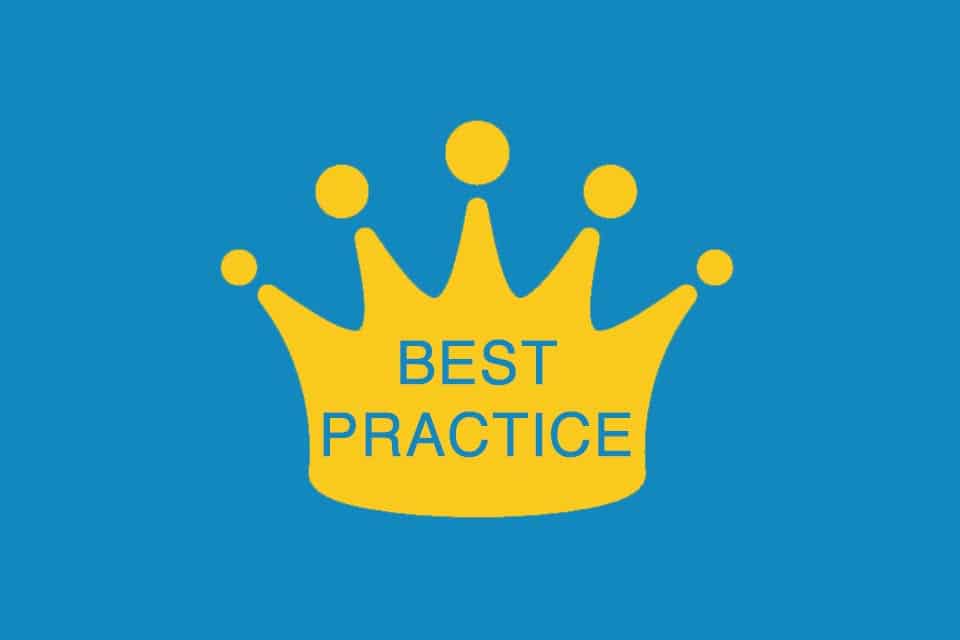What is Best Practice?
Smartpedia: A best practice is a proven procedure, method or habit for performing a repetitive activity or project in the most optimal way.
Best practice as a recipe for success for processes, projects, developments
Companies try to produce results as efficiently and effectively as possible. A best practice is a proven approach, procedure or method to perform a repetitive activity or project in the most optimal way. It is a kind of pattern that is used to produce a defined result. In the truest sense of the term, a best practice refers to an “excellent pattern” that is used to produce a defined result. For this reason, best practices are seen as recipes for success that organisations have developed over time and which they apply in appropriate situations, projects, developments.
Best Practices as orientation at the best
In principle, a best practice addresses the orientation at the best. Organisations ideally learn from their experiences and then improve their processes. Since this can be time-consuming depending on the task or the project, many companies try to orient themselves by benchmarking on the positive findings of an industry and use the experience of other companies. This leads, for example, to numerous suggestions in articles, blogs or books such as how online marketing works best, when Facebook ads should be placed or how employee communication ideally works. Of course, it makes sense to look for best practice examples – inside and outside an organisation. The concrete use of findings in comparable situations is a good idea, for example.
- in IT in the procurement of computers and the organization of service level agreements,
- in production, e.g. in stakeholder analysis, in the development of pretotypes and prototypes, or in the design of production facilities,
- in project management in the planning and design of projects, in the use of processes and process models, or in the use of checklists,
- in requirements management, e.g. in the definition of user stories, in apprenticing or in the determination of consistent requirements,
- in software development by using development environments, using design patterns or designing UML diagrams etc.
Within individual industries, companies that stand out from the crowd through benchmarking also become increasingly apparent. For example, awards such as “Best Places to Work” or “Top Company” also emerge, indicating that organisations act in an exemplary manner with their employees.
The development of best practices
How can a best practice be developed? With patience, time and the continuous effort to “get better”. Different approaches and methods are similar in reality:
- The Deming Cycle describes a cycle consisting of Plan – Do – Check – Act and thus four phases in a repetitive process.
- Inspect and Adapt is a similar approach that examines aspects of the (agile) procedure in short cycles and adapts them if necessary.
- The so-called Continuous Improvement Process – abbreviated as CIP – also addresses steady improvements in small steps.
- In the benchmarking already mentioned, the focus is on the outside – on other industries or on competitors – in order to gain impulses for improvements. These impulses can then be incorporated into each of the approaches mentioned.
It is important to note that the development of best practices is never a goal but only a result. No organisation tries to “develop best practices”, but they all want to “get better”. Best practices “emerge” over time. In fact, they could also arise during the application of Inspect and Adapt, during the Deming Cycle or in the course of CIP and optimise the implementation of the approaches.
Best practice as a blueprint
Sometimes it can be read that a best practice is the best realised solution to a challenge that can be empirically determined by benchmarking. Such a statement is misleading in two respects: First, most so-called best practices are not determined or validated by empirical methods. And secondly, best practices are not blueprints that can be applied to tasks or situations easily or even unchecked in practice and lead directly to the desired success. In some discussions, the alternative use of good practices is therefore recommended.
An additional aspect is highlighted by the term “Best Current Practice”: the current status of a good practice. This status can change over time. Again, this is a hint, a procedure, a workflow, or a process not to be applied unchecked in a project.
And what comes after a best practice? If it is a cross-company, possibly industry-wide accepted approach, it can even become a standard; e.g. ReqIF, the standardised exchange format for requirements in the automotive industry.
Notes:
If you like the article or would like to discuss it, please feel free to share it in your network. And if you have any comments, please do not hesitate to send us a message.
Best practices are often identified in lessons learned sessions.
Here you can find a video about best practices.
AI prompt template for best practice
I am working on the following topic: [Enter topic here – e.g. ‘Effectively managing change requests in project management’]
You are an experienced practitioner and absolute expert with in-depth knowledge in this area.
I am looking for a best practice that has proven itself in this context – not general recommendations, but rather:
A concrete measure or approach that really works
An example of a scenario in which it works particularly well
An explanation of what many people do wrong when implementing it
And if possible: An unusual but helpful idea or a rare piece of experience
If you need more context for a well-founded answer, please ask me specific questions.
Here you will additional information from our t2informatik Blog:



